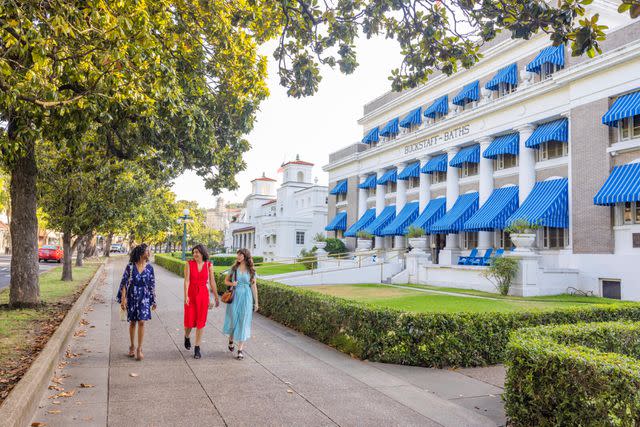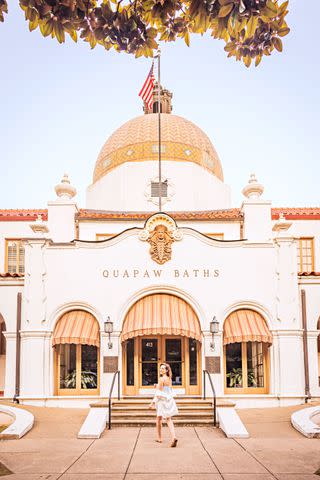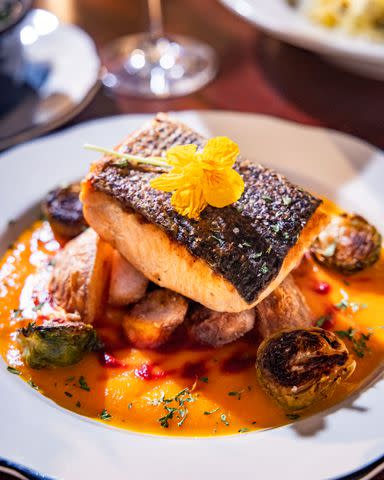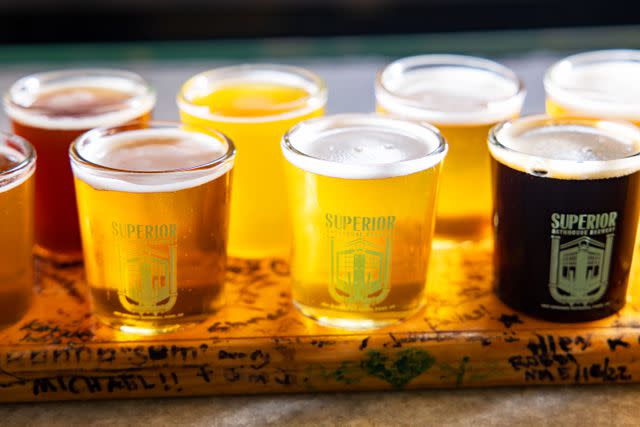There's Something Special About The Water In Hot Springs, Arkansas
Hot Springs, Arkansas, one of America’s oldest national parks, is both a geothermal marvel and a refreshing getaway in Central Arkansas.
:max_bytes(150000):strip_icc():format(jpeg)/27295_HotSprings_11w-98be9870cda84f3fa40b80bc296ac9ec.jpg)
Robbie Caponetto
At the corner of Central Avenue and Reserve Street stands a pale yellow basin ringed with silver taps. No matter the time of day, there’s usually a cluster of people standing around it, each of them filling up empty bottles and gallon jugs. This is a free public fountain, one of several in the area, and it provides a taste of the waters that have stirred the legend of Hot Springs, Arkansas, for centuries.
As a resource, water is often taken for granted, but in this patch of the state, it’s impossible to ignore. Located at the base of Hot Springs Mountain are 47 springs, and the fabled liquid they release averages a steamy 143 degrees Fahrenheit. Nestled in the Ouachita Mountains, Hot Springs National Park surrounds the namesake town, and its centerpiece is the water.
Geothermal Wonders
Although it seems like magic when you see the steam rising from the earth, the geologic process that heats the water below the park takes 4,400 years to complete. That means what emerges today entered the ground when the pyramids were still new. The heat comes not from volcanic activity but from the liquid’s long journey beneath the surface. It moves through folded and fractured rock, a matrix that is filled with small fissures through which the rain seeps. It continues down for 4,000 years and then back up for 400, warming and absorbing minerals as it goes.
The thermal springs gave rise to a community and still power the area’s tourism. “People’s relationship to water is different here,” says Ashley Waymouth, the interpretation programs manager for Hot Springs National Park, which manages the water. Around 700,000 gallons are collected each day and can be accessed at no cost from the area’s public taps. “We celebrated the 100th anniversary of the park in 2021, which sounds like a long time,” she says, “but because of the scale of our resource, we have to take an even longer perspective. We are impacting the water for people thousands of years from now, so we have to continue asking ourselves ‘Are we being good stewards of this resource?’ and planning accordingly.”
Today, most of the springs around Bathhouse Row, the showpiece of the park, are capped to preserve water quality, but you can still see two in motion, one along the promenade—the brick walkway tucked behind the row that’s ideal for quiet strolls beyond busy Central Avenue—and the other along Arlington Lawn at the north end of the thoroughfare. Stand by the uncapped springs long enough, and you’ll begin to feel an uncanny warmth emanating from the rippling pools. What bubbles there is one of the many aquatic wonders that make Hot Springs a legendary waterfront town.
Related: 15 Best Weekend Getaways In Arkansas

Robbie Caponetto
Bathhouse RowBuilding Spa City
Early entrepreneurs saw money-making opportunities in the springs, and they built bathhouses and drew tourists with rumors of the waters’ curative properties. Those claims have since been dispelled, but the bathhouses remain. And the visitors still arrive in droves—2022 saw a record-breaking 2.6 million people.
Hot Springs soon became a spa city teeming with those who “took the waters” or “quaffed the elixir.” They also brought their doctors, each of whom wrote prescriptions aimed at treating patients holistically, long before the term became a health buzzword. Typical guidance included drinking a cup every day, soaking in the thermal waters at the baths, and taking hikes along the mountain that rises behind the magnolia-lined Bathhouse Row.
The eight bathhouses that stand side by side along Central Avenue were built between 1892 and 1923, and each has its own distinct architectural style. Fordyce Bathhouse opened in 1915 as the grandest of them all with its ornate facade, panes of stained glass, white marble staircases, sunny sitting rooms, and sprawling square footage. It is now a museum and visitors center for the park, and its rooms and exhibitions bring its golden age to life. There is something astonishing around every corner: lavish parlors, spacious bathing halls, an old-fashioned gymnasium, embellished fountains, and a cavernous basement revealing glimpses of the mechanics of the spa.
These places had their heyday in the early 1900s, and during that time, gambling also thrived. Just across the street from Bathhouse Row, a statue of Al Capone, who was one of Hot Springs’ most famous visitors, can be found reclining on a bench outside The Ohio Club. Once a bar and casino, it now has food, drinks, and live music.

Robbie Caponetto
Quapaw Bathhouse offers the spa services the row is famous for.Bathhouse Row's Revival
The popularity of the bathhouses declined during the latter half of the 20th century, and by the 1980s, almost all of them had closed. To reinvigorate the attraction, Hot Springs National Park developed a historic leasing program to bring new businesses into the storied structures. Two of the other buildings, Quapaw Bathhouse and Buckstaff Bathhouse, still hold spas that enable guests to soak in the waters and book other treatments, but the rest have new uses. Lamar Bathhouse was turned into an emporium and gift shop, while Hale Bathhouse was transformed into the nine-room Hotel Hale, complete with Eden Restaurant and tubs that fill with the park’s spring water.

Robbie Caponetto
Eden Restaurant in Hotel Hale to dine on dishes like seared salmon.One of the most creative new businesses in the park can be found at the north end of the row. Eleven years ago, Rose Schweikhart, a musician and home brewer, jumped at the opportunity to lease a bathhouse. She wondered how a town famous for its water didn’t already have a brewery, and after a few tests, soon discovered that it was, in fact, an ideal resource for making beer. She opened Superior Bathhouse Brewery in the former spa of the same name, and it became an instant favorite.

Robbie Caponetto
Visit Superior Bathhouse Brewery for spring-enriched beers.“Beer is 95% water,” Schweikhart explains, “and the minerals in it can affect clarity and mouthfeel, which makes this special water a hallmark of our brews. I want that distinct flavor to come through, because we’re the only brewery in the country that makes beer with thermal water.” Schweikhart’s team puts out craft beers and seasonal selections and names some of them after local places, like the Northwoods IPA, which is a nod to a 31-mile mountain-biking trail system north of town. A family-friendly spot, Superior Bathhouse Brewery has also added food to its offerings and a patio to its footprint. The latter is a breezy place to end the day after enjoying the park and walking around town.

Robbie Caponetto
Hickory Nut Mountain Vista Overlook in the Ouachita National ForestBeyond the Springs
This is also a region rich in lakes and other natural beauty. Lake Ouachita State Park, Ouachita National Forest, and Lake Catherine State Park are nearby, and Garvan Woodland Gardens is situated south of town on the Ouachita River. Owned by the University of Arkansas, the 210-acre botanical paradise is home to landscaped grounds, outdoor sculptures, and the breathtaking Anthony Chapel (a timber-and-glass structure that rises among the trees and filters sunlight like a prism).
The town and the park are also full of opportunities for exploring, from mountain biking at Northwoods Trails to hiking park paths that wind around Hot Springs Mountain. Accessible from up to panoramic views.
Dig into some Arkansas delicacies at family-owned McClard’s Bar-B-Q and Morrison’s Fried Pies, a truck that makes magic from flaky dough and delicious fillings. Be sure to stop by DeLuca’s Pizza and SQZBX Brewery & Pizza Joint, which are musts after working up an appetite hiking the trails and boating the waterways.
Around town, everyone has a different story to tell about where they came from and where they’re headed, but they can all agree on what brought them here: There’s something undeniably special about Hot Springs.
For more Southern Living news, make sure to sign up for our newsletter!
Read the original article on Southern Living.

